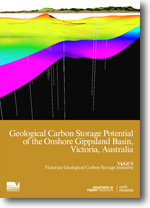VicGCS Report 2 - Geological Carbon Storage Potential of the Onshore Gippsland Basin, Victoria, Australia
 |
| |||||
Product description:Executive summary In this report, the regional geological carbon storage (GCS) potential of the onshore Gippsland Basin is discussed, particularly in relation to the Victorian Government’s newly offered GCS areas, GCS09-1 and GCS09-2. The sealing potential (containment), reservoir characteristics (injectivity and capacity) and the potential impacts of CO2 injection have been considered at a high level and six GCS play fairways or play concepts have been defined. The play fairways involve two stratigraphically deeper storage concepts, namely localised sands within the Tyers River Subgroup and the upper (Albian-Aptian) Strzelecki Group; and storage plays within the younger Golden Beach, Halibut, Cobia and top Latrobe Group (Oligocene) sequences. Saline aquifer trapping appears to be the most likely storage option in all six plays. The stratigraphically deepest plays, involving the lower (Tyers River Subgroup) and upper Strzelecki Group, are located within both exploration tender areas and comprise apparently localised sands within a stratigraphy dominated by lithic, volcaniclastic sandstones and mudstones. The critical technical uncertainty in both Strzelecki Group plays is low reservoir permeability. In the Latrobe Valley (GCS09-1), siliciclastic play options are limited to the Strzelecki Group, in particular the Tyers River Subgroup. The identification of suitable storage sites in these deeper plays will rely upon the development of a robust depositional model and an understanding of the distribution of primary porosity within the reservoirs. In particular, the details of where and how both porosity and permeability have been either preserved or lost due to diagenesis and compaction (due to burial-uplift cycles) will be critical. The likely potential resource conflicts associated with the geological storage of CO2 within the Strzelecki Group are as yet undiscovered petroleum and geothermal resources. The stratigraphically shallower top Latrobe Group and intraformational Latrobe Group plays occur exclusively within GCS09-2 and are located in the Seaspray and Lake Wellington depressions, relatively close to the coast. A qualitative assessment of seal potential, integrating both the characterisation of the regional Lakes Entrance Formation top seal and empirical evidence of seal failure indicates that the top seal over the central eastern Lake Wellington Depression and the southern to central nearshore areas in the Seaspray Depression are very suitable for the containment of supercritical CO2. However, the Lakes Entrance Formation appears to have poor retention capacity for CO2 across the Baragwanath Anticline, in the Alberton Depression and over the Lakes Entrance Platform, due to the seal being thin to absent or of poor quality. The presence of possible gas chimneys and soil gas anomalies along the Darriman, Rosedale and Lake Wellington fault systems highlights the need to better understand the leakage and seepage processes in the area, especially in relation to reactivated faults in areas of thin seals. Data on Latrobe Group reservoir quality in the Lake Wellington and Seaspray depressions are sparse; porosities are mostly greater than 20%, although permeabilities are highly variable. The Cobia, Halibut, Golden Beach and Emperor subgroups are all present in the Seaspray Depression, which potentially increases the geological carbon storage play options, particularly if intraformational seals are delineated in future studies. The identification of Latrobe Group faults and fault seal integrity is a key component in reducing the uncertainties associated with potential sites, particularly in the intraformational Latrobe Group. The likely potential resource conflicts associated with the geological storage of CO2 in the Latrobe Group within the onshore Gippsland Basin are deep, potable groundwater resources and petroleum, geothermal and coal resources. The total storage capacity of the onshore Gippsland Basin is unknown, although it is clearly one to two orders of magnitude less than that of the offshore part of the basin. The geoscience data which are currently available across the onshore basin are inadequate to undertake quantitative modelling or estimation of storage potential, with current estimates (0-65 Mt) based upon a combination of the total sealed pore volume and inferred saturation efficiencies within saline aquifers. A program of new data collection is required; these data would in turn allow for more accurate estimates of storage capacity and also the assessment of potential impacts on other earth resources. The present study, whilst regional in nature, provides a precompetitive geological framework for the assessment of blocks GCS09-1 and GCS09-2 and also forms the basis for the subsequent exploration and site characterisation evaluation phases. Download The downloadable version of this report is supplied in PDF format and is a large file (16.0MB). Related geoscience information is also supplied for use in GIS software (ZIP 31.6MB). Bibliographic reference Goldie Divko, L.M., Campi, M.J., Tingate, P.R., O'Brien, G.W. & Harrison, M.L., 2009. Geological Carbon Storage Potential of the Onshore Gippsland Basin, Victoria, Australia. GeoScience Victoria VicGCS report 2. | ||||||

